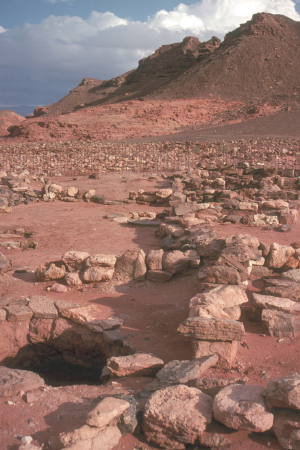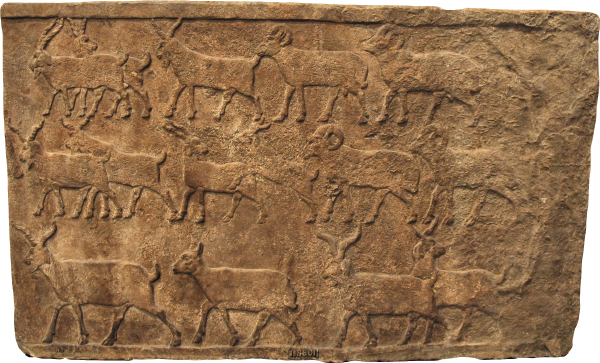The Midianite Campaign (31:1–54)
Midianites (31:2). The Midianites are an enigmatic people in biblical, historical, and archaeological research (for more on this people group, see comments on 10:29; 12:1; 22:4). Moses fled to the region of Midian from Egypt, labored in the Midianite household of Jethro (Reuel), married one of his seven daughters (Zipporah), and first encountered the Lord in the theophany at the burning bush (Ex. 2:15—3:4). Egyptian records seem to subsume groups such as the Midianites under the heading of the shasu, a group of pastoralists and village raiders. Recent excavations in northwest Arabia and at Timna in the southern Arabah have yielded a stylistic pottery from the thirteenth to the twelfth centuries B.C. that may be Midianite.282

Timna
Bible Scene Multimedia/Maurice Thompson
Vengeance (31:3). Here are the demands of all-out holy war: (1) driving out human populations (33:50–53), and in some cases the total annihilation of human life in a given area for purging of idolatry and its temptations (Deut. 20:16–19); (2) subjugating women who are not killed (21:10–14); and (3) banning certain objects and materials from the public usage (7:5, 24–26; Josh. 6:18–19). These requirements were intended for Israel during the period of the late second to early first millennia B.C.; regarding the moral and ethical concerns of holy war, God often provided a prior option that would alleviate destruction (i.e., conversion).
The Mesha Stele from Moab (ca. 830 B.C.) describes a similar holy war strategy when King Mesha celebrated the rebellion and victory against Israel: “So I went by night and fought against it from the break of dawn till noon, taking it and slaying all, seven thousand men, boys, women, girls, and maidservants, for I had devoted them to destruction for (the god) Ashtar-Chemosh.”283
Articles from the sanctuary (31:6). Scholars have debated which holy implements may have been taken from the sanctuary into battle. Some have suggested the ark of the covenant, but others disagree.284 It seems, however, that if the ark of the covenant were intended by this phrase, it would have been mentioned as when the Israelites tried to use it against the Philistines in the battle of Aphek-Ebenezer (1 Sam. 4:3–11). Noordtzij and Milgrom suggest these vessels were the Urim and Thummim, but Ashley notes that this is unlikely since they were kept by the high priest.285 Harrison suggests these are the signal trumpets, which were kept in the sanctuary for their regular cultic usage and for waging battle (see comment on 10:9).
Evi, Rekem, Zur, Hur and Reba (31:8). The names of the five kings are recounted again in the same order in the battle summary of Joshua 13:21, where they are called princes of Sihon. The precise political relationships among the Amorites, Moabites, and Midianites remain somewhat nebulous. These Midianites chieftains may have been subject to Sihon prior to the defeat of the Amorites and then gained their independence through the earlier Israelite victory.
Zur was the father of Cozbi, the Midianite woman killed by Phinehas along with her Israelite paramour, Zimri ben Salu (Num. 25:14–18). Zur and Zimri are both regarded as patriarchal clan leaders.286 On the title “king” (melek), see comment on 20:14.
Purify yourselves (31:19). The purpose of holy war was the eradication of all impure elements from the geographical region or ethnic territory placed under the ban. Coming on the heels of an idolatrous and adulterous affair at Baal Peor involving Israelite and non-Israelite participants, a cleansing of the camp was needed for the sanctity and purity of the community. The violence of war brings death and a state of ritual impurity through contact with the dead.
Gold, silver . . . put through the fire (31:22–23). This new ordinance has to do with the purification of metallic products by means of fire because they can withstand the high temperatures. Perishable goods such as glass beads, clothing, wood, leather, animals, and other organic commodities are to be purified with water, probably through washing, and then put through the waters of purification made from fresh water and the ashes of the red cow.
Divide the spoils (31:27). This instruction for distributing the spoils of war among the community members sets the standard for the coming campaigns in the Promised Land. In many other marauding cultures of the ancient Near East, the warriors retained whatever goods or persons they captured during and after battle, with certain portions being allocated to the king and his court and other portions rewarded to the priesthoods of the patron deity of that people.
Tribute (31:28). The term for tribute (mekes) occurs three times in this chapter but nowhere else in the Hebrew Bible. This term is attested in Ugaritic (mekes) and Akkadian (miksu) and occurs often in later rabbinic sources.287 The tradition in Abraham’s day was a tithe of ten percent presented to the temple priesthood, as he did with the spoils of war confiscated from the battle against the four kings of Mesopotamia (Gen. 14:1–24).
Plunder remaining (31:32). These totals are much higher than those confiscated in the campaign of Thutmose III of Egypt (ca. 1460 B.C.) during his campaign against Megiddo and other northern Canaanite cities. The Karnak temple account lists booty of 1,929 cattle, 2,000 goats, 20,500 sheep, and 2,503 slaves (men, women, and children), along with a variety of physical objects such as gold bowls and ebony statues.288 Wenham suggests an adjustment should be made to the numbers by analogy with the two census summaries of 1:1–46 and 26:1–51. Humphreys’ analysis and assessment of the number of people in the Exodus from Egypt are in order here to clarify the interpretation.289

Booty: flocks captured from Arabs
Todd Bolen/www.BiblePlaces.com
Gold articles (31:50). The amount of the gold offered by Israel’s commanders on behalf of their troops exceeds the minimal requirement of one-half shekel per person, a ransom of some 6,000 shekels, or about 2,500 ounces = 158 pounds of gold. Instead, they present nearly three times the minimal amount, with a combined weight of the armlets, bracelets, signet rings, earrings, and necklaces totaling 16,750 shekels = 7,000 ounces = 440 pounds of gold.
This much gold seems phenomenal considering the seminomadic nature of the Midianites. Yet they traveled the caravan routes into Arabia and beyond by which such wealth could have come, and adornment in gold is still prized today among Bedouins. Samples of such wealth occasionally find their way into burials. Note the excavation of Tel Beth Shean, in which material goods from a child burial from the Middle Bronze II (Hyksos) period (ca. 1700 B.C.) include an ornate white alabaster vase, four gold earrings, and a gold ring with an etched amethyst mounted on it with gold thread.